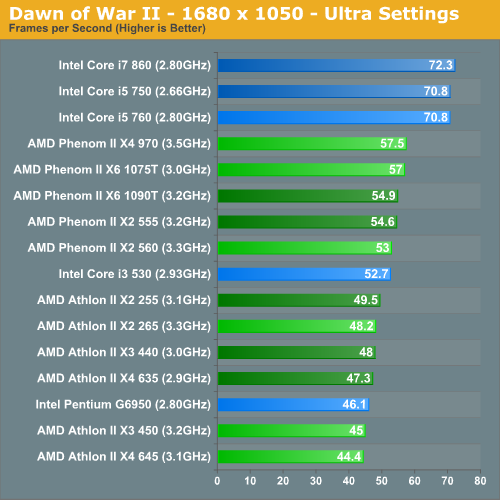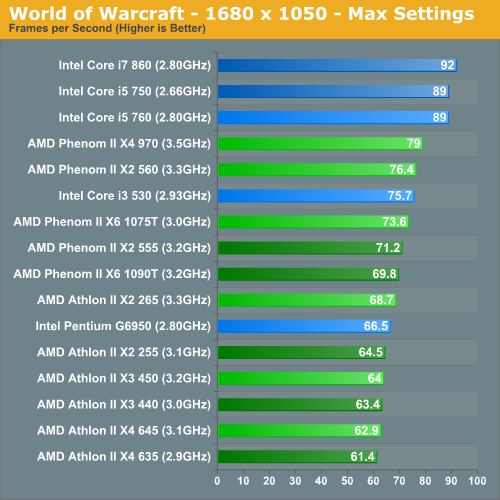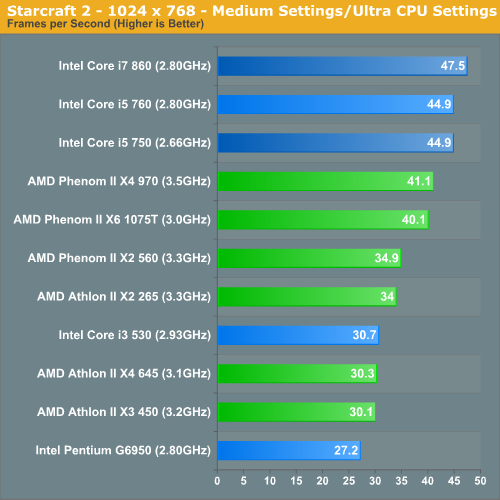AMD's Fall Refresh: New Phenom II and Athlon II CPUs Balance Price and Performance
by Anand Lal Shimpi on September 21, 2010 2:52 AM EST- Posted in
- CPUs
- AMD
- Phenom II X6
- Athlon II
Sonar 8 Audio Mixing Performance
In our only digital audio production test we take a multi-track recording and export it to a WAV file using Sonar 8. The benchmark isn't very well threaded and prefers two very fast cores to several slower ones:

As I mentioned before, this is the biggest issue with AMD's lineup. If you're running applications that can't use the extra cores, AMD's advantage typically disappears.
Gaming Performance

At the high end, AMD's Phenom II X6 and X4 lose to the similarly priced Lynnfields. In the middle the Athlon II X4 645 and Athlon II X3 450 do very well.

With the exception of the Phenom II X6 and X4 processors, AMD is generally competitive here. Intel maintains the performance advantage above $200. There's an unusual amount of variance in our tests here (particularly old vs. new AMD results). The variance appears to be caused by the platform shift as we moved all of our AMD testing to the same 890GX motherboard. The change in performance under Dawn of War II however doesn't really change the standings.

WoW performance is governed by two threads thus negating any core count advantage. AMD loses at the high end but is competitive around the $100 mark.

Starcraft 2 performance is something we're beginning to look at. Again we have a situation where a game doesn't use more than two cores. The Phenom IIs are slower than Lynnfield, while the multi-core Athlon IIs do well against their competitors. If you're building a fast Starcraft 2 box that doesn't have to do anything else, the dual-core CPUs do better here.










98 Comments
View All Comments
KikassAssassin - Tuesday, September 21, 2010 - link
On page 1: "The Core i3 540 is priced similarly but you only get two cores, and no Hyper Threading to bridge the gap."The Core i3 does have HyperThreading. The only Clarkdale CPU without HyperThreading is the Pentium G6950.
quiksilvr - Tuesday, September 21, 2010 - link
One issue I'm having is the weird color scheme in your graphs. Just make all AMDs green and all Intel's blue. Stop mixing and matching randomly. It makes the colors useless and misleading.Anand Lal Shimpi - Tuesday, September 21, 2010 - link
I only highlighted the new chips we were focusing on. I debated doing it the other way (AMD green, Intel blue) but figured the focus should be on the new chips. I can understand the confusion though. I've updated the graphs to reflect green for AMD and blue for Intel, if everyone is ok with it I'll keep it :)Take care,
Anand
quiksilvr - Tuesday, September 21, 2010 - link
Much appreciated! A suggestion could be this to differentiate between old and new:Light Blue for New Intels
Dark and less saturated Blue for Old Intels
Light Green for New AMDs
Dark and less saturated Green for Old AMDs
vol7ron - Tuesday, September 21, 2010 - link
This sounds good to me - just don't make the contrast too different that we have to look at 4 different colors. The greens should be close enough in spectrum that they can be distinguished but close to the same hue (same for the blue).That way looking at a glance your brain can quickly compare overall AMD vs Intel, but then giving it more consideration you can tell what's new/old.
KikassAssassin - Tuesday, September 21, 2010 - link
This sounds like the best option to me.JarredWalton - Tuesday, September 21, 2010 - link
I've updated the graphs to use the dark/light colors, though I'm not sure how "new" some of the Intel parts are. Anyway, at least there's a bit of separation to make things "visible".quiksilvr - Tuesday, September 21, 2010 - link
You guys are awesome! You're like, one of the busiest gadget sites on the web yet you took the time to read my suggestion and actually implement it!High five!
(turns off Adblock for Anandtech.com)
vol7ron - Wednesday, September 22, 2010 - link
i think the light green is a little too light, but much betterfoundchild1 - Tuesday, September 21, 2010 - link
Have you guys ever thought about placing the prices of the chips in the benchmark tables for easy price reference? Perhaps just to the right of the benchmarks?Just a suggestion!
Thanks for this update as well, AMD is starting to regain my interest.